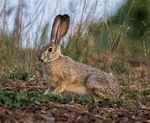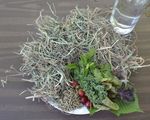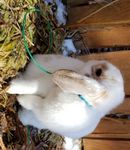Pet Rabbit Projects: Getting Started - Melanie Stock, Jessie Hadfield, Jake Hadfield, and Nicole Reed - DigitalCommons@USU
←
→
Page content transcription
If your browser does not render page correctly, please read the page content below
4-H
extension.usu.edu
Pet Rabbit Projects: Getting Started
Melanie Stock, Jessie Hadfield, Jake Hadfield, and Nicole Reed
Rabbits are becoming increasingly popular companion animals. Pet rabbits can thrive in rural and suburban
environments and can happily live indoors or outside. They are relatively low maintenance compared to some of the
more common family pets and are great for all ages of youth with proper supervision and education. It is important not
to be fooled into thinking they are an easy pet, however. Rabbits are a long-term
commitment that require daily care and continued effort. This fact sheet has tips
to get started keeping rabbits as pets.
Housing and Supplies
The very first step to starting a pet rabbit project is to make sure you have
appropriate housing and supplies.
Pet rabbits can be kept indoors (known as house rabbits), outdoors, or both. One
advantage of house rabbits is that they become part of the family and enjoy
feeling part of the daily commotion. Outdoor rabbits require less daily cleaning
and maintenance, but sometimes do not bond with family members as readily.
A rabbit cage should be 4-6 times larger than the rabbit, allow the rabbit to lay
down, and hop at least twice in each direction, but the larger the enclosure, the
better. Table 1 breaks down the minimum sizes of an enclosure for a single rabbit, as recommended by the American
Rabbit Breeders Association (ARBA). Rabbits can also cohabitate and most enjoy the companionship. However, separate
cages are needed if more than one rabbit is not altered (spayed or neutered) or the rabbits do not get along.
Regardless of where rabbits are kept, cages must be cleaned frequently. Rabbit manure and most bedding is an excellent
source for home composts.
Indoors: Table 1. Minimum cage sizes (ARBA, 2011)
Rather than having free range of the house, most house rabbits have their Mature Weight Cage Size
own cage inside the home and spend time in the home only when 5 pounds or less •18 inches deep
supervised. Special care must be taken to bunny-proof the home so that •24 inches wide
pets cannot accidentally chew wires, dig and chew up carpet, or other •12 inches high
potentially dangerous habits. Rabbits are smart and naturally clean. They 6 to 10 pounds •24 inches deep
can be litter trained to make cage cleaning easier and allow for supervised •24-36 inches wide
out-of-cage time. Litter boxes can be as simple as a 9”x 9” container or •18 inches high
store-bought corner box with high sides. Training is easiest when rabbits are 11 pounds or •24 inches deep
altered and older, but any rabbit can be litter box trained with the right more •36-48 inches wide
handling. For more specific tips on litter training, visit here: •18 inches high
https://extension.usu.edu/utah4h/programs/companion-animals.
USU Extension Publications | January 2021 | 4H/01 1Outdoors:
Rabbits can also be kept outdoors in secure hutches that
provide shelter from the weather and protection from
wildlife. Other options include rabbit tractors, or hutches with
an open bottom that allow rabbits to graze on grass (Figure
2). When using a tractor, move the enclosure regularly to
provide fresh forage and check for signs of digging.
Selection
Once you have the proper housing, finding the perfect pet is
the next step. There are several places to find rabbits needing
new homes. For pet rabbits, consider adopting from an
animal shelter. These rabbits have had a health check by a
Figure 2. A rabbit tractor.
veterinarian and are often already spayed or neutered. If a
specific breed or breed type is desired, only purchase from
reputable breeders that breed humanely, with purpose, and have a good relationship with a veterinarian. Avoid hobby
breeders who are merely trying to breed rabbits for the fun of it, and often overlook basic rabbit husbandry needs. The
term “backyard breeder” is sometimes used to describe these breeders, but the size or location of a breeder’s herd does
not matter, as long as the breeder follows best practices. If you need help finding reputable breeders, reach out to your
local Extension office.
Unlike rabbits intended for showing or commercial uses, there are no set criteria for
selecting a pet rabbit. The most important thing is to find a rabbit that will be a
good fit for the entire family. This makes temperament a primary consideration for
your new pet. Each rabbit has a unique personality. Some are bold and social, while
others are nervous and shy. The following factors all affect a rabbit’s temperament:
breed, handling, age, and whether the rabbit is altered. Although young rabbits are
undoubtedly the most attractive to potential buyers, older rabbits are calmer and
easier to train. Rabbits live 8 to 14 years, so an older, calmer rabbit may still have
plenty of life left and provide a better experience for first time rabbit owners.
Figure 3. A Holland Lop on a leash.
The American Rabbit Breeders Association recognizes 49 rabbit breeds, each with distinct characteristics. You can find a
complete list of ARBA recognized breeds here: https://arba.net/recognized-breeds/. If you find a breed that catches
your eye, you can do some more research to find out if that breed is a good fit. When researching these breeds, keep in
mind that small rabbits, like the Netherland Dwarf or Polish, are often higher
energy and more fragile than large ones. Large rabbit breeds, such as the Flemish
Giant, tend to be more docile, but may also be harder for a small child to handle
and care for. Although wooly breeds like the Angora, American Fuzzy Lop, or Jersey
Wooly are all very cute, their hair requires much more maintenance than a smooth
coated rabbit.
With all these domesticated breeds to choose from, do not “rescue” a wild rabbit
(Figure 4). Wild rabbits are a different species and cannot be tamed. They do not
make good pets, and humans cannot create good lives for them.
Figure 4. A wild rabbit. Photo by
Jason Leung on Unsplash.
Nutrition
Good nutrition is essential for your pet rabbit’s health. Rabbits are sensitive to what they eat and sudden changes in diet
can cause fatal gastrointestinal upset. When you get ready to take your rabbit home, ask for a sample of the foods that
he or she has been eating, and then slowly transition to any new things over a period of a few days. Rabbits should have
an unlimited supply of water and be fed grass hay, leafy greens, healthy fruit and vegetables, and pellets. Figure 5
demonstrates what a proper proportion of feed would look like for your pet rabbit, and the list below gives you some
specifics to get started.
USU Extension Publications | January 2021 | 4H/01 2• Grass hay is 80% of the diet and is important for the
digestive system. Timothy hay is the best type for rabbits,
while orchard grass and alfalfa should be avoided due to high
protein contents.
• Leafy green vegetables are 10% of the diet. Romaine lettuce
(not iceberg), kale, carrot tops, dandelion greens, and
raspberry leaves are all excellent examples of leafy greens.
• Healthy fruit and vegetable treats are 5% of the diet. Carrots,
broccoli, and fruits can be given as daily treats.
• Healthy pellets are only 5% of a rabbit’s diet. ¼ - ½ cup of
fresh pellets that have at least an 18% protein content can be
fed per 6 lbs of rabbit. A diet too heavy in pellets can lead to
diarrhea and weight gain. Figure 5. An example of a well-balanced rabbit diet.
See the Nutrition Guide for Rabbits for a complete list of foods that rabbits can – and cannot – eat.
https://digitalcommons.usu.edu/extension_curall/2133/.
Rabbits should also have access to salt licks and materials to chew, as teeth grow continually and are worn down with
chewing. Pruned branches or store-bought wooden rabbit toys are good options. These items will help keep teeth at an
appropriate length, and many rabbits find them entertaining as well.
Handling and Behavior
Adults need to supervise young children during handling because rabbits are easily frightened
and have delicate bodies. It is best to be sitting when handling them (Figure 6).
Rabbits groom themselves and one another frequently. They do not need baths and do not like
being wet. Combing and trimming fur is important for any breed during shedding season and
long-haired breeds year-round. Combing must be done gently, as rabbits have thin skin that can
tear. Rabbits also need their nails trimmed and should be checked every 6 weeks. See the Nail
Trimming Guide for Rabbits for information. For more information on nail trimming, visit this
website: https://extension.usu.edu/utah4h/programs/companion-animals.
Rabbits can have strong personalities, but males and females become more calm and less
territorial if they are neutered and spayed. Altered rabbits also live longer, can cohabitate with a
Figure 6. Sitting with friend, will not spray or mark territory, are easier to train, and will not add to the overpopulation
a harnessed rabbit. of unwanted animals.
References
American Rabbit Breeders Association (ABRA). 2019. https://arba.net/.
Hadfield, J. 2020. Companion Animals. Utah 4-H. USU Extension. https://extension.usu.edu/utah4h/programs/companion-animals.
House Rabbit Society. 2020. Care. https://rabbit.org/care-2/.
Pratt, A., M. Stock, and J. Hadfield. 2020. Nutrition Guide for Rabbits. All Current Publications. Paper 2133.
https://digitalcommons.usu.edu/extension_curall/2133.
Reed, N. and A. Christensen. 2019. Understanding the Basics of Rabbit Care. All Current Publications. Paper 1955.
https://digitalcommons.usu.edu/extension_curall/1955.
The Ohio State University. 2019. Rabbit Resource Handbook: for Breeding, Market, and Pet Rabbit Projects. OSU Extension
Publications, 134 pp.
Disclaimers
Photos should not be used without written permission from the authors. Figures 1-3 & 5-6 by J. Hadfield, J. Hadfield, and M. Stock.
Utah State University is an affirmative action/equal opportunity institution and is committed to a learning and working environment free from
discrimination. For USU’s non-discrimination notice, see equity.usu.edu/non-discrimination.
USU Extension Publications | January 2021 | 4H/01 3You can also read























































